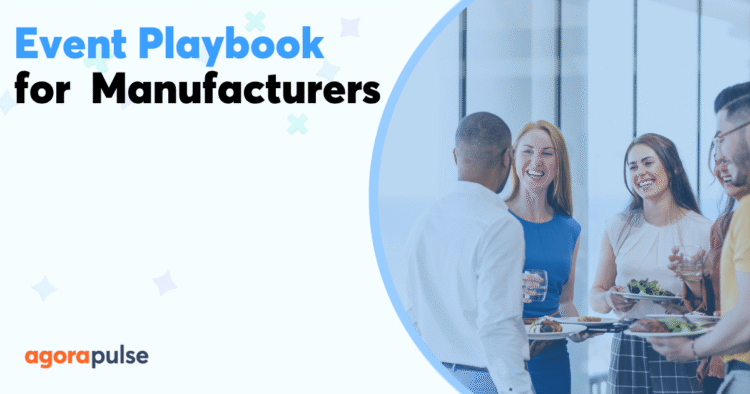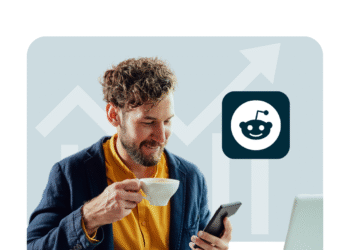For manufacturers, an industry trade show or conference is a powerful engine for audience development and brand awareness. With an estimated 13,000 trade shows held in the United States each year, those events are crucial touchpoints.
Manufacturing shows are known for attracting high-value attendees: an estimated 78% of attendees have purchasing power, and 46% hold executive-level positions. That concentrated value means your social media strategy must be precise.
The core principle for success? Education over immediate conversion.
You’re not at an event to sell products today; you’re there to gain mindshare for future purchases, develop valuable relationships, and drive discovery.
Your social media team should act like industry journalists, providing unbiased, high-value insights and reports on manufacturing trends.
Success at an event is built in the 4–6 weeks leading up to it. The hard work in this phase is crucial to achieving your longer-term goals.
Set focused goals
Before you post a single graphic, you must define the measurable results you want. Don’t just aim for “awareness.”
Be specific with your social media goals:
- Total impressions
Set a concrete target for the overall reach of your content in the weeks leading up to the event. - “Saves” or “shares”
Define a goal for how many times your educational content (e.g., infographics, trend articles) is saved or shared. This is a powerful indicator of audience value. - Targeted engagement
Identify 5–10 key industry analysts or journalists. Create a plan to tag and engage them in your pre-event content to amplify reach.
Content planning and scheduling
Your pre-event content must establish your company as a proactive industry leader. Remember, 81% of consumers state they need to trust a brand before buying from them, according to Edelman’s Brand Trust Report.
Demonstrate that you’re more than just another exhibitor.
Content Strategy: Polling and Graphics
Post interactive content (polls, simple graphics) asking the audience about their biggest challenges related to the event’s focus. (e.g., “What’s holding back your automation line?”)
Key objective: Show you understand your audience’s pain points.
Content Strategy: Trend Forecasting
Publish a short graphic or brief article about “3 Trends to Watch.” Then promote the executive who will discuss these at the event.
Key objective: Subtly link your presence to thought leadership.
Content Strategy: Event Survival Guide
Create a helpful, non-promotional guide focused on the attendee experience *(e.g., “Must-See Keynotes”).
Key objective: Position your brand as a helpful partner and utility resource.
Content Strategy: Hashtag Strategy
Make your company’s “findability” easier. Use the official event hashtag for event-specific engagement, but focus heavily on broad, discovery-oriented hashtags relevant to your industry and the event’s themes (e.g., #FutureOfManufacturing, #SupplyChainSolutions, #IndustrialAutomation).
Also, tag relevant industry groups and event partners to borrow their audience.
Live Brand Reporting From the Event
On the show floor, your social media team’s primary role is to act as an objective industry reporter, not a direct sales representative.
Some 96% of the most successful B2B content marketers believe audiences regard their organization as a credible resource.
Focus on creating high-value, shareable content that captures the pulse of the industry.
Create content assets from the live event
Live content demonstrates how quickly your team can craft valuable, engaging content in real time.
Content Asset Idea: Show Floor Observations
Format and focus: 60-second vertical videos on “Top 3 Things We Saw Today That Will Change Your 2026 Strategy.” Focus on broad trends, not products.
Key objective: Immediate, high-impact insights; captures the excitement of the event
Content Asset Idea: Expert Soundbites
Format and focus: Record short, on-the-spot interviews with industry experts, partners, or neutral analysts about high-level topics.
Key objective: Positions your brand as a connector and source of diverse perspectives.
Content Asset Idea: Key Takeaways
Format and focus: Post rapid-fire summaries of key quotes, statistics, and data points from major speakers using engaging text overlays and graphics.
Key objective: Provides real-time value and shareable micro-content
Content Asset Idea: “Walk the Floor” Snapshots
Format and focus: Share educational posts highlighting interesting, non-competitive machinery or innovations seen around the event.
Key objective: Reinforces the “reporter” mindset and industry mastery
Drive engagement via social media
Engagement should be designed to drive deeper conversation and increase content longevity:
- Open-ended replies: Respond to comments by asking further, open-ended questions (e.g., “That’s a great point! What impact do you think that trend will have on smaller manufacturers?”).
- Act as a hub: Share posts from event organizers, speakers, and reputable industry voices, positioning your brand as a connective hub for industry dialogue.
- Encourage UGC: Provide “Instagrammable moments” at your booth or around your product to encourage user-generated content (UGC), then share it.
- Monitor conversations: Constantly monitor the event hashtag to join in existing conversations.
Post-Event Follow-up and Evergreen Content
The immediate 24 to 48 hours post-event are critical for synthesizing the value you captured and driving continued interest.
Summarize what was learned
- Trend spotting: Publish a compelling 24-hour summary post that links out to a long-form article on your blog. What did you see on the immediate horizon that your customers need to know about?
- Next-step education: Use the summary to invite followers to download a white paper or attend a generic webinar on the overall industry topic. The brand promotion must remain subtle.
Repurpose content for long-term value
Maximize the content you produced during the event to last for the next few months:
- Long-form video: Produce a professionally edited 3-minute video: “What the Event Taught Us About [Industry Problem].” This is high-quality, shareable content for LinkedIn and YouTube.
- Infographics: Create shareable, data-rich graphics summarizing statistics and predictions gathered from the event.
- TOFU lead magnet: Package all interviews, keynote takeaways, and trend reports into a single, comprehensive, downloadable annual event report. This non-salesy asset is your best lead magnet for capturing new contacts
Measurement and reporting
Reporting must tie back to your initial awareness goals:
- Analyze content shares, total impressions, and follower growth during the event and the 30-day post-event window.
- Track traffic from social posts to your new evergreen content (reports, white papers) to see which social channels are driving the highest-quality initial interest.
Virtual Events
Virtual events require an engagement-focused strategy to overcome the lack of physical presence. Tweak your approach for the online world:
Pre-event push
Focus promotional content on the value of the speaker and topic (e.g., “Unlock the Future of AI in Welding”), not the platform. Use LinkedIn Event pages for tracking RSVPs and creating a community feel.
Live coverage
Drive real-time interaction by heavily promoting the Q&A window on social media during the session. Also, live-tweet key quotes and statistics using the event hashtag.
Post-event on-demand
The full recording is a valuable Top of Funnel (TOFU) asset.
- Heavy promotion: Promote the on-demand link heavily for 30 days post-event.
- Micro-content creation: Chop the full webinar into 3–5 short clips (15–60 seconds) for use as teasers to drive traffic back to the full recording.
Quick Reference: Content Best Practices
Keep the following in mind.
- Use neutral, educational language.
- Avoid product pricing or direct lead calls-to-action (“Request a Demo”).
- Focus 80% on the industry and 20% on your company.
- Never sound overly salesy or use aggressive, competitive language.
- Use high-quality graphics and professional video.
- Don’t wait to share—live content requires speed and immediacy.
- Engage with curiosity. Ask more questions than you answer in the comments.
- Don’t ignore the competition. Report on their trends (generically) to show industry mastery.
Ready to start dominating your next event with social media? Sign up for a free trial of Agorapulse to get started.















